We braved the north of India for nearly a week to visit the holy city of Amritsar and to see its two great sights: the Golden Temple, center of the Sikh religion, and the Indian-Pakistani border at Wagah, which holds a much-vaunted closing ceremony. One of those sights we got to enjoy very much, as we visited the Golden Temple the second night we arrived.
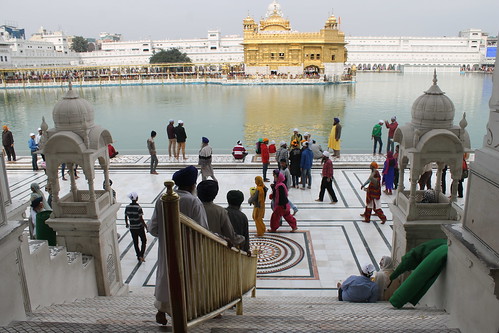
We stayed in a hotel barely minutes away from the Golden Temple. As soon as we were headed inside, I felt the atmosphere change. Though people surrounded us, their glances were more frank and curious than probing and assessing, and no one approached us to ask if we wanted to buy something or if we needed a taxi. Wonders of all wonders! Here, few were curious visitors like us — many more were believers and true Sikhs. Sikhism dictates that inside the temple, all must go barefeet and with their heads covered. (Hence the turban you’ve probably seen Sikh men wear.) At the entrance, we approached the shoe storage center to hand them our shoes and receive a silvery token in return, carved with elaborate numbers. Steve also stopped at a bin filled with squares of orange cloth and bandannas, and fished out one to wrap around his head. He looked a little like a pirate!
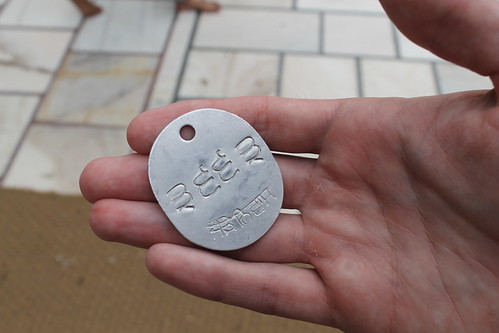

Inside, the Golden Temple is beautiful. Known also as Harmandir Sahib, it is a large white square that encircles a rectangular pool, which is filled with holy water. From one side, a walkway extends out to the center of the pool, where the Golden Temple sits, a smaller, ornate golden rectangle. The air is filled with the sound of melodic chanting and singing from a loudspeaker, and its text outlined on screens at the corners of the square. We saw hundreds and hundreds of pilgrims there, even at night, with their families, dressed in their brightest and best. At the corners of the pool where places where women could go inside to wash themselves in the pool in private. Many men simply stripped to their underclothing and washed themselves directly. There are large koi in the holy pool, probably more than ten pounds heavy.

It was soothing to be in an atmosphere where so many were sincere and respectful. We’ve seen a lot of filth, a lot of yelling, and honking and pushing in India so far, so this was definitely a treat. Many people spent time simply sitting by the pool, kneeling and kissing the ground of the holy artifacts and altars around the Golden Temple. Though people were curious about us as visitors, only a few spoke to us — two men asked Steve to take pictures with them, and he obliged them. What purpose those photos will serve, I can’t surmise, but this post from Laowai Comics (a favorite of Steve’s) comes in handy.
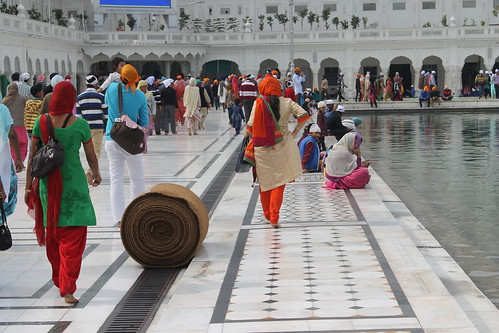
Our visit the first night was brief, but yesterday, we came again during the day, and found a far bigger crowd. I was approached twice by a group of young boys who were giggling and matching our pace for a few minutes before one found the courage to address me as “ma’am” and ask for a photograph. Their faces, merry and shy when we spoke, got so serious for the pictures! In a way, it’s nice to be such celebrities when it’s treated this way. The second group of boys found us while we were going through the Sikh Museum, housed in one part of the white buildings that surround the holy pool. They don’t allow photography in there in general, which is just fine by me. Sikhism, as a religion of non-violence, has a long and very bloody history of martyrdom. We were regaled with paintings (and worse, photographs) of famed martyrs who had died in gory ways at a young age and stories of massacres. I probably would have had nightmares later if I were six years-old and wandering through this museum!
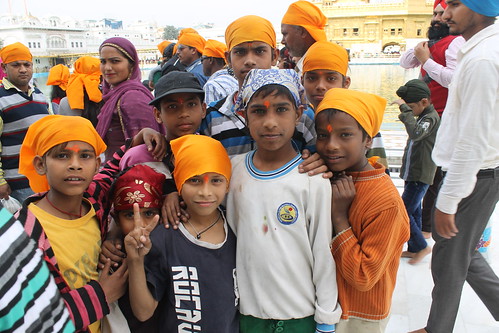
After we came out, we found our way to the langar, which was the free common kitchen and cafeteria I had heard about from many others. A key part of Sikhism is also their willingness to embrace people of all different races, colors, and faiths. To show that, their common kitchen is open to all, and the Golden Temple runs one of the world’s largest soup kitchens. We grabbed a metal thali plate, bowl, and spoon from volunteers downstairs, and proceeded with a mass of other visitors to the second floor, where we waited on an outdoor balcony. I could see inside hundreds of people all sitting on the floor and eating their fill. When they vacated, the doors were opened to us, and people rushed in. We hurriedly found seating on the floor, where people sat back to back on long strips of carpets with their dishes in front of them. Moments later, people started coming by with buckets and ladles, pouring out dark green dal and sweet white rice pudding. Several men also came by with baskets of flour chapatis, for which you had to cup both hands to receive. The food was very simple, but filling, and it was an experience that I’m going to think about in the future. It was very noisy and quick at the time, but we ate with what Steve estimated was about 600 people in the same room, families, young and old. We were given food free of judgment for who I was or how much money I had or where I was from. On the way out, we passed our dirty dishes to an army of volunteers, who were washing, drying, and cleaning the dishes with an unholy amount of noise. On the other side of our path, there was a similarly large group of volunteers sitting on the ground, peeling vegetables and preparing the food. It was an impressive sight.


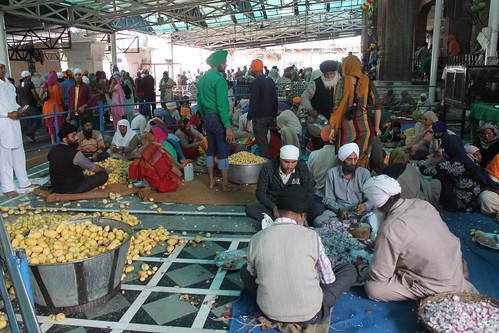
We wrapped up the afternoon with a visit to Jallianwala Bagh, the park just five minutes away from the Golden Temple. We learned a little bit more about Indian history from this park, which has a similarly tragic past. In spring of 1919, the British government passed the Rowlatt Act to exercise a tighter hold on its Indian protectorate. As a summary, the Rowlatt Act allowed the British to hold prisoners suspected of terrorism or revolutionary activities to be held without a trial for up to two years and other harsh measures. It provoked many gatherings and protests in India, including one in Amritsar. Here, in April, British troops massacred more than 1,000 men, women, and children at one such large gathering at Jallianwala Bagh. The uproar over it contributed to India’s bid for independence, and the fallen revered as martyrs for the cause of India’s independence. The land was afterwards purchased, and a memorial park designed and constructed. It’s now a beautiful memorial park to those massacred almost a hundred years ago. Children ran about with kites, and families picnicked on the grass. Several buildings and walls still stand, their brick surfaces showing where bullets had been fired. One corner shows a well where people ran to avoid the gunfire and drowned; over 120 bodies had been recovered from it. It was a very strange contrast to walk around and see these pieces of history, and also the merry spirit of the visitors. We were even approached by a few women who shyly asked me where we were from, and another two men took Steve’s picture. The history though is interesting in a way it wouldn’t have been if we stopped at a small town where a minor Civil War battle had been fought. It is a reminder that each country has their own history, bright and dark.
Finally, I want to write about what I appreciated from this experience. Amritsar proper is very dusty, poor, and not quite a tourist destination. Trekking all that way seemed excessive to us, because being at the Golden Temple seemed underwhelming at first. Thinking on it now, I can better identify what was moving about it and harmonious and why I will remember this city. We have been a part of many crowds on this trip and lived in large cities, but the bustle created by a city is that of thousands of people brushing by each other on the streets on the way to furthering their own aims. You can still feel lonely or set apart from them, because the presence of other people is just an incidental part of your day. Here, even though it was nothing to the crowds I’ve seen in Beijing at rush hour, people were focused on the common objective of being here and being with each other. That is the kind of presence that does not detract from a destination, like a crowd in front of the Mona Lisa might, because you are here for worship, to be one of many. That energy swept us up, and it was a unique moment that I enjoyed.
Belatedly, I want to mention that we never did see the border closing at Wagah, thanks to the amount of time we had to spend sniffling, sneezing, and laid up in bed. We were both very out of sorts, and had kept to eating almost exclusively Subway in order to give our bodies the food they were used to. I’m frustrated that we didn’t get to see the border closing, but know well enough that our health is the most important thing. Tomorrow, we board a train to Kochi, Kerala, and brave crowds of a different sort for the warmer, more humid south. And we’ll have stories (I’m sure) of the train.
Connie
this was a delightful read. i’d love to hear more about this experience… transformation of space by ritual and collective sentiment are my JAM. the common kitchen sounds unreal. wonder if they would have let you help peel potatoes…
I think they would’ve let us help out! Apparently they’re all volunteers. I read somewhere that all Sikhs have to volunteer a week in their lives at the Golden Temple. There were really way too many people helping out, as you can tell, but many, many, many hands make very light work. =) We should definitely talk more about it. It was a very quietly special experience.